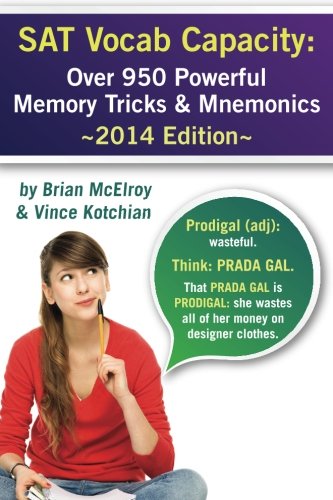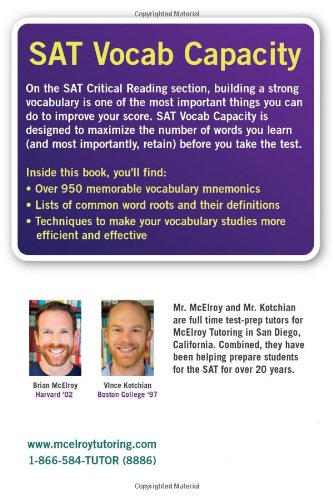


Full description not available
T**E
FUNNY AND EASY TO USE-- SAT PREP TUTOR APPROVED!!!
I tutor SAT reading & writing prep, and I bought this book to vet it for my students -- I wanted a resource that was going to help them more easily memorize the HUNDREDS of words that they'd been assigned in way that didn't engender the same feelings as watching paint dry. Well, I can say that this book was FANTASTIC for what I was looking for!! The mnemonic techniques are funny, make the words super-memorable, and I was SOOOOO quick to recommend it to my students immediately. As an added plus, when I tried to return the book (as I said, I was just vetting it for my kids, I didn't need one myself), the return process was super easy as well. Good experience all around!!!!Mnemonic examples used in this book:Aplomb (noun): confidence. Think "The BOMB." If you have APLOMB, you think you're the BOMB!Platitude (noun): an overused expression. Think "BLAH ATTITUDE." Dude, she's giving you that BLAH ATTITUDE cause your pickup line was a PLATITUDE.Surreptitious (adjective): sneaky or stealthy. Think: "REPTILES." REPTILES like snakes are good at camouflage because they're SURREPTITIOUS.
K**M
Great help for mastering vocabulary -- great resource for teachers, too!
SAT VOCAB CAPACITY, by Brian McElroy and Vince Kotchian, is a clever and useful book aimed at helping teenagers prepare for the SAT and other standardized tests. The book focuses on mnemonics, or memory devices that can help students link unfamiliar words with those they already know, or with images and patterns that can help their minds remember. The book is clearly organized and easy to use - each of the words listed includes its part of speech, a simple definition, a mnemonic clue, and a sentence in which both the target word and the mnemonic are used. Here's an example:Fetid (adjective): bad-smellingThink: FEETFEET often are FETID.The beauty of this is the information is short and to the point. The idea that feet smell bad is a universal one, so it's likely that students using this book will make the connection easily.McElroy and Kotchian offer a nice introduction with good tips to help students use the book and learn the words. There's also an appendix on "Word Roots," which is a good way for students to decipher the meaning of unfamiliar words simply by recognizing common roots (i.e. if you know that "dem" refers to people, you'll be able to figure out that "democracy" is about government by the people).This book is aimed at teenagers, and as such many of the mnemonics suggested might work better for kids than they will for adults. But the method is what's most important here, and McElroy and Kotchian do suggest that students add to the book by creating mnemonics of their own to better help them remember.I recommend this for anyone interested in improving their vocabulary, as well as for teachers looking for help with vocabulary lessons. I was a teacher for many years, and I regularly made up mnemonics like these to help my students learn vocabulary words - this book would have been a huge help! Students who follow the authors' tips on how to learn the words in this book will no doubt improve both their vocabulary and their test scores.[I was provided a copy of this book for review; the opinions expressed here are my own.]
I**N
This memory technique works to improve one's vocabulary
This is a very helpful book that should help both people who will be taking an SAT test and those who simply want to improve their vocabulary. The authors use the well-known proven technique of association to help users memorize new words. They have over 950 words that vary from level 1 basic words that could appear on any level of an exam, words all English speakers should know, such as belittle, daunt, mundane, and euphemism; level 2 challenging words that commonly appear on tests, such as curtail, bereft, and bifurcated; level three words that appear rarely, as moribund, cupidity, chicanery, and choleric; and level 4 uncommon words that probably won’t appear on tests but might be useful to know. Each of the over 950 words have their level indicated next to them.The authors include pages in which they define word roots. Knowing the meaning of roots helps people deduce the meaning of words. Examples are: am = love, as in amour; ag = to do, as in agent; ac = sharp, as acid There is also an index of all the words that the book defines.The following are examples of how the authors help readers memorize level 3 words:Refulgent (adjective): brightly shinning. 3Think: Refuels it.The campfire gets refulgent after he refuels it.Refractory (adjective): stubborn, unmanageable. 3Think: re-fractureThe refractory athlete insisted on playing despite his broken toe; unsurprisingly, he re-fractured it.
Trustpilot
1 month ago
1 day ago